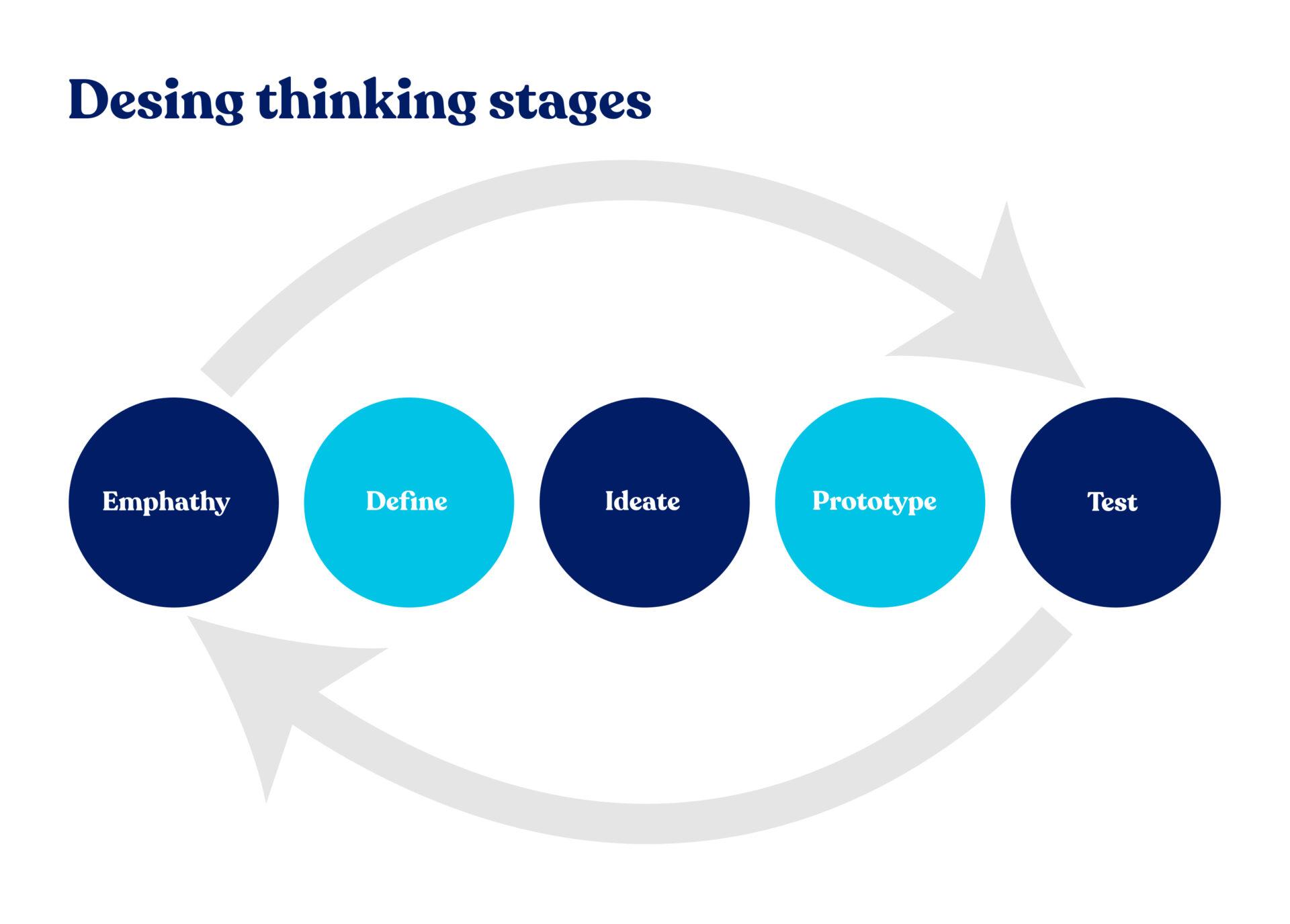Listen to the article
TL;DR: Design thinking might be simple to label as a direct opponent to analytical thinking. However, in this blog, our UI/UX designer, Celia Altamirano, shares her insight from more than 10 years of experience with design and digital production. She’s explaining why design and analytical thinking are actually complementary and ultimately lead to user-centered design to fulfill vital user and business needs.
On this note, we’re not just covering the basics on design thinking. Doing so can actually be quite simple to achieve. What we’re honestly excited to discuss with you right now is why design thinking (DT) continues to prevail in the business world, and how it differs from analytical thinking.
What’s considered a contrary force is actually complementary
Design thinking is traditionally considered the antithesis of analytical thinking. Yet, after many years working in design and digital production, I consider the two to be complementary to each other. Product design is precisely based on the complementary relation that exists between analytical and design thinking.
Design thinking, in general terms, is a structured methodology. Worked out in stages we describe in detail below, its goal is to create solutions that focus on an end user.
It’s commonly said that analytical thinking focuses on captivating financial value while design thinking is aimed at creating an emotional and functional value. We’ll go deeper into this difference more in detail very soon, and I’ll justify why, in my opinion, both are actually linked to value generation through experiences. For that, however, we’ll first need to go over basic definitions of design thinking and how important it is to put these concepts in their historical context.
The five design thinking stages
DT works through five stages. The first of them is empathy with the second being problem definition. From here, we move on to ideation. And the last two are prototyping and testing.
In the empathy stage, we seek to understand the end user. For that, we engage in wide research. We use empathy maps, user journeys, interviews, and other data captivation tools as instruments. All of them serve to analyze what people say versus what they do along with what they think and feel. For this, it’s crucial to acknowledge that not everything a person tells us about their behavior matches their exact experience.
Big data and analytics are helping out generously here, too, as they provide honest data based on actual user behavior. Even our own research bias is cleared with them. With these tools, we can better understand user patterns, including purchasing and behavioral trends.
With the above understanding, we can engage in definition, a second stage very much tied to the first. In it, we seek to combine our entire research material to define where our users’ problem lies.
The DT structure can be considered a double diamond figure precisely because these first few stages seek to generate options while the counterpart starts defining. At first, we work with empathy to understand and start making definitions. Then, as another fold of this double diamond, we move on to the third stage, which consists of coming up with all sorts of creative ideas. That’s why we title that third part ideation, precisely. From here, the process continues with representations of those ideas in our prototyping stage.
Related read: Disabilities, design, and UX accessibility
Testing is somehow a later phase, because, as a main characteristic of DT, this process is truly iterative. In this final stage, we go to our end users for feedback before materializing a final vision. Important to note about this cycle is how our ideation phase incorporates many of the results we get from our testing stage.

History matters when it comes to design thinking
When DT was created, and this is very much related to the creation of innovation, we had been working in design in the same way since the third industrial revolution. According to this model, we created economies by placing products at the center of our attention. By that, we also mean services as a product and everything related to technology development. This is how there was great competition on the use of tech innovation at the service of patents, for example. Our efforts all evolved around building great products.
Then, a digital transformation started. Technologies became much more available to all. Patents started becoming easily reproduced. And this unleashed a process that stopped being sustainable. We started creating products consumers didn’t actually use.
I personally remember that, when I started in this discipline, some websites would win tons of awards. Yet, they took a really long time to load! Their animations were outstanding, but you could barely locate buttons or action items in them. We didn’t even know how to relate to them! The purpose of what we were doing got lost for a moment in history, and user needs dropped in level of priority. It’s as if we got sidetracked.
Design thinking approaches placed users at the center
DT was able to focus on the generation of sustainable products or services. With it, the goal stopped being so much about consumerism, and we honed in on need satisfaction. We no longer created products for sales, but sought to satisfy client needs.
This is where the most fascinating aspect of DT stands. Design thinking is about looking for a solution that’s not just functional, but also emotional. We can start speaking about an experience economy as of this point in history, as well.
Millennials’ experience economy matters in discussing design thinking
Validated research has indicated that “More than 3 in 4 millennials (78%) would choose to spend money on a desirable experience or event over buying something desirable.” This is relevant insofar it ties in with the fourth industrial revolution. This fourth revolution kicks off with a lack of limits in terms of the physical, biological, and digital aspects of the world. In that process, exponential technologies also move on to this experience economy.
Back to the common differentiation between analytical thinking versus DT that I promised at the start of this blog, I believe design thinking is as much as analytical thinking as of the fourth industrial revolution seek to generate value. It’s just understandable that value now comes in the form of experiences. Yet, we all place users or clients at the center of business as well as of technology and innovation development.
Design thinking enables the smartest of business choices
What’s interesting from a business perspective on this topic is that, at this time, all of our products are similar. And all of our technologies are quite comparable. The difference here lies in processes of high performance. How those are attained is by making the smartest decisions.
Take Shimano, the famous bicycle component manufacturer, into account. They tapped into riders’ emotional and functional needs to innovate in their field with data backup. This company’s understanding of precise consumer use helped them dominate their market. According to Harvard Business School’s Digital Initiative, as of 2015, Shimano already had “about 70% of global share in bicycle gears and brakes, and approx. 50% of the overall bicycle components market.” This company’s net worth as of September 05, 2022 is $15.45B.
Considering user feelings and thoughts in business decisions
Antonio Damasio, a Portuguese neuroscientist, has said “humans are not either thinking machines or feeling machines but rather feeling machines that think.” In my perspective, looking for emotional and functional solutions means reaching a point of balance from an analytical thinking standpoint as much as a DT one.
In this field, we seek a balance between business problems and user needs. We’re after that which can connect both. As our UI/UX Design Lead has presented previously, “Designing and developing with an accessible mindset provides users with a better and more pleasant experience.” What we also know for a fact is that emotion is relevant in doing business. It’s key for product design, as well.
If you think about it, products rarely change. What we do is alter how we use fairly similar products. Take a knife as a final example. Knives solely vary in accordance to where, how, and under which circumstances we use them, but the product itself is generally and essentially the same in all its forms.
Innovation isn’t really about creating something new. It’s about anchoring our offer to reach an outstanding balance between business solutions and user needs.
Learn more about our UI/UX Design Services.
Was this article insightful? Then don’t forget to look at other blog posts and follow us on LinkedIn, Twitter, Facebook, and Instagram.








